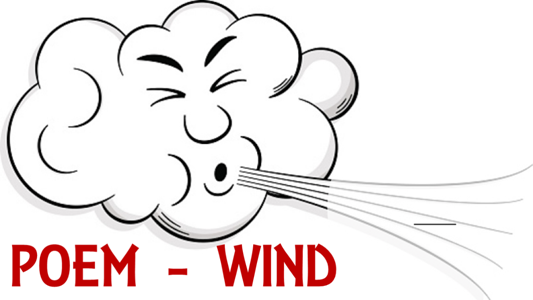Class 9 Beehive Poem Chapter 2 Important Question Answers - Wind
Short Answer Type Questions
Q1. Describe the central idea of the poem.

Ans: The poem “Wind” encourages us to face life's challenges with resilience and determination. It teaches us to be strong and courageous when confronting the hardships that life presents. In the poem, the wind in highlighted multiple times. ymbolizes the difficulties and obstacles we encounter at various points in our lives.
Q2. Is the wind regarded as a symbol of destruction in the poem? Explain.
Ans: Yes, in the poem, the wind is portrayed as a force of destruction, especially in the first stanza. It tears pages from books, disrupts daily life, and represents chaos, particularly affecting the weaker sections of society. The strong winds symbolise life's turbulence, which we must learn to endure.
Q3. What are the figures of speech in the poem 'Wind'?
Ans: The prominent figure of speech in the poem is Anaphora, which is evident in the repetition of the word "don't" in the opening lines. Furthermore, the entire poem serves as a metaphor, encouraging humanity to remain resilient against various challenges, whether they are natural or man-made.
Q4. What does the wind do with the books?
Ans: The wind scatters the pages of books, causing them to fly off shelves and create disorder. It disrupts the order of the environment, leading to books and papers falling and littering the ground.
Q5. Explain the line: "You brought rain again" or How does the wind bring rain?
Ans: This line illustrates how the wind carries clouds filled with rain, leading to rainfall. The movement of the wind can result in storms and heavy downpours, which can sometimes cause destruction and damage.

Long Answer Type Questions
Q1. What challenges are posed by wind in the life of the poet and the common man?
Ans: The wind disrupts daily life, representing the unpredictable challenges we encounter. The poet suggests that the wind and rain are powerful forces of nature that metaphorically eliminate negativity and weakness within us. Similar to life's problems, the wind can strike unexpectedly, testing our physical and mental strength. For those who are weak, the wind creates significant obstacles. However, for the strong, the wind is not a threat but a challenge to overcome. The poem conveys that resilience and inner strength are essential for enduring life's adversities.
Q2. Does the poem reflect human suffering caused by the wind? Explain with examples.
Ans: Yes, the poem reflects the suffering caused by the wind, which acts as a metaphor for life's challenges. The wind, although invisible, leaves visible effects, similar to how unseen forces shape our experiences. The poem highlights both the destructive and constructive powers of the wind. While it brings chaos and suffering, it also encourages individuals to grow stronger.
In this context, the wind represents divine will, serving as both a trial and a teacher. Its destructive force emphasises the struggles that humans face, while also showcasing the resilience required to overcome suffering.
Q3. Which values of life does the poet emphasize in the poem?
Ans: In "Wind," the poet Subramania Bharati highlights the values of strength, courage, and resilience. He uses the wind as a metaphor for life's challenges, illustrating that only those who are mentally and physically strong can endure hardships. The poem suggests that difficulties, much like the wind, test our resolve. Those with unwavering courage and determination can overcome obstacles, while the weak are often defeated. Bharati advocates for a life of strength, encouraging individuals to confront challenges directly and emerge victorious.
Q4. Why does the poet suggest that people need to be strong?
Ans: The poet emphasises the importance of strength, both physical and mental, for overcoming life's challenges. The wind represents these challenges, which can easily break the weak but have no effect on the strong. The poet encourages us to build strong homes and to develop inner resilience to withstand the wind's force. Only those with inner fortitude can endure life's trials, while the weak may be overwhelmed. This poem serves as a reminder to cultivate resilience in order to face the inevitable difficulties we encounter.
Q5. The wind is a symbol of power and strength. How can we befriend it and survive in our struggle for existence?
Ans: The wind symbolises power, representing the forces of life that can either uplift or overwhelm us. To survive and thrive, we must cultivate inner strength and resilience. By constructing strong homes, both literally and metaphorically, we equip ourselves to face challenges. Befriending the wind means developing the fortitude to withstand its force. Only those who are physically and mentally robust can endure life's hardships. Therefore, strengthening our bodies and minds is essential to face the wind—and life's struggles—without succumbing to defeat.
|
119 videos|620 docs|82 tests
|
FAQs on Class 9 Beehive Poem Chapter 2 Important Question Answers - Wind
| $1. What are the main themes of the poem "Wind"? |  |
| $2. How does the poet personify the wind in the poem? |  |
| $3. What literary devices are used in the poem "Wind"? |  |
| $4. How does the poem suggest one should deal with challenges? |  |
| $5. What message does the poet convey about nature through the poem "Wind"? |  |



















